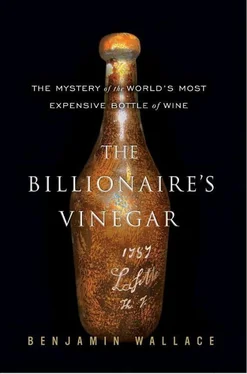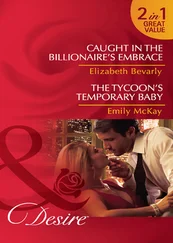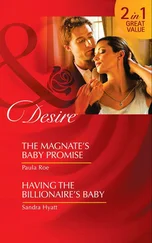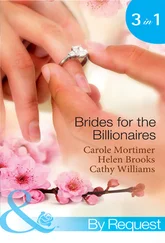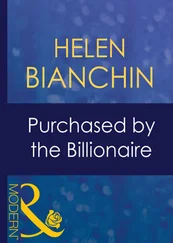A LOWER-TECH EXAM, in the end, was what settled the matter.
After the disappointment of Philippe Hubert’s tests, Jim Elroy had been running his fingers over one of the Jefferson bottles when it occurred to him to have the engraving analyzed. Elroy had the bottles examined by two experts, one an engraver who worked near the Corning Museum of Glass in upstate New York, the other a former tool-mark specialist with the FBI, who scrutinized the inscriptions much more thoroughly than the Christie’s ceramics and glass department had in 1985. These experts had access to pedal-driven eighteenth-century engraving equipment, and Elroy bought some old bottles to experiment on. They tried to reproduce the engravings.
The size of the apparatus required for wheel-engraving drove home the fact that the “Jefferson bottles” would have had to be sent to an expert engraver, which didn’t fit neatly with the narrative of offhanded bottle-marking long conjured by Broadbent and Rodenstock. More damning, the experiments made it clear that the Jefferson bottles couldn’t have been engraved using a pedal-driven copper wheel, which would have resulted in more-ragged lines. Instead, the bottles had clearly been engraved by a modern method: a power tool with a flexible shaft.
Probably a dental drill.
“We believe Rodenstock did the drilling himself,” Brad Goldstein said. “It’s easy. Jim did it.”
CHAPTER 19

TAILING MEINHARD
IT WAS JUST BEFORE CHRISTMAS 2005, AND BILL KOCH sat at a table in his fourteenth-floor corner office in West Palm Beach, quietly cocky as he described his planned response to his investigators’ findings. “I don’t like lawsuits,” Koch said, “but they can be a good tool.”
The room featured views of the water and souvenirs from his America’s Cup win. Koch often wore conservative suits lined with psychedelic vintage Pucci silk—a sartorial expression of what he considered to be his hidden wildness—but on this day, with his baggy dark brown khakis, striped button-down shirt, and mop of white hair, he looked like a suburban Midwestern dad. A recent knee replacement had left him with a temporary limp, but he was as aggressive as ever.
His doubts mounting, Koch had decided to yank his bottles from the MFA show, at the last minute changing the catalog wording to “reputedly purchased by Thomas Jefferson.” But pulling the bottles from the MFA show only motivated him to further expand the investigation.
By now, Jim Elroy had zeroed in on Hardy Rodenstock, searching for any and all biographical information about the elusive German. As with Koch’s lawsuits against his brothers and his preparation for the America’s Cup, when he deployed frogmen and spy helicopters to gather intelligence, Koch availed himself of a range of investigative tactics. His team, led by Elroy, had tracked Rodenstock to Hong Kong. Among the facts the investigators learned was something Ralf Frenzel had stumbled upon twenty years earlier: “Hardy Rodenstock” was a fictitious name. Hardy Rodenstock was really Meinhard Görke.
Frenzel had been eating at a restaurant in Essen in the 1980s when the waiter said, “You work with my father.” The waiter’s last name was Görke, and he informed Frenzel that he was the son of Meinhard Görke, better known as Hardy Rodenstock. This was the first Frenzel had heard of Rodenstock not being Hardy’s real name, of his being a father, and of his having been previously married. The name change didn’t strike Frenzel as a big deal. In the German music business, stage names were common. Rodenstock’s girlfriend, Tina York, and her sister Mary Roos had been born Monika and Rosemarie Schwab, and Jack White, a Berlin music producer who was a regular at Rodenstock’s tastings, had changed his name from Horst Nussbaum. It was the secrecy about Rodenstock’s real name—and his family—that made an impression on Frenzel. When he mentioned the encounter with the son, Rodenstock seemed unsettled.
Two decades later, Koch’s investigators, who viewed the name change in a more sinister light, were discovering other interesting things as well, including the fact that Rodenstock owned a company that manufactured perfumes and essences. And they had obtained the sealed court documents from the Frericks dispute. They were amazed to learn that, contrary to all the press reports at the time, a court had decisively sided with Frericks (when the Munich court, on December 14, 1992, found that Rodenstock “adulterated the wine or knowingly offered adulterated wine”). The investigators’ findings now filled a fat spiral dossier and two CD-ROMs.
ELROY WAS EMPLOYING some “very clever” methods in his investigation, Koch said now at his office as he stood up to go to lunch. Koch drove a visitor, along with Oxbow’s publicist, Brad Goldstein, and general counsel, Richard Callahan, in his Maybach to the Palm Beach Yacht Club. The car featured a flat-screen TV on the back of each seat, puffy headrests, and four different cell phones positioned around the wood interior. At lunch, Koch sat with his back to the water. He reported that Broadbent was backpedaling now, saying the wine “tasted like a wine of that period” and retreating from the assertion that it was definitely Jefferson’s. He said he was about two months away from being ready to sue.
Koch told a story about a nationally prominent appellate lawyer who had stayed at his house and was discovered trying to abscond with $70,000 of Koch’s wine in his suitcase. He told other stories about wine merchants he’d sued over undelivered wine, and a wine consultancy he had funded that had become, without his knowledge, a party to tax evasion. And he and Goldstein described how Goldstein had approached Wine Spectator to offer it an exclusive on the story of a spectacular fraud. Although Wine Spectator had covered several episodes in the Jefferson bottles’ history, despite Marvin Shanken’s ownership of one, the editors now demurred, saying it was “a sensitive subject.” That was the Goldstein/Koch version of events, anyway. Later, Thomas Matthews, the magazine’s executive editor, wouldn’t recall Goldstein specifying that the bottles at issue were the Jefferson bottles; the magazine had been covering counterfeit wine for years, and according to Matthews, Goldstein had demanded that Koch himself author the article. “We don’t let a collector write his own story and make allegations we haven’t investigated,” Matthews says. In any case, all these experiences had soured Koch on the wine world.
Nor were any of the chief members of his legal and investigative team likely to have leapt to the defense of that world. Callahan, Koch’s lawyer, allowed somewhat sheepishly that he ordered cardboard boxes of wine from a Massachusetts chain retailer and kept them in his basement. Goldstein, compact and pugnacious, seemed intimidated when it came to wine. In general, he brought the native cynicism of a former investigative reporter to his work: he suspected that Hardy Rodenstock and Michael Broadbent had a hidden financial relationship. He assumed Bill Sokolin had been an insurance scammer. He was quick to question whether even documents signed by Rodenstock had actually been written by him. He spoke with a hardboiled swagger, saying things like “We’ll keep going until that man feels my breath on the back of his neck.”
For all his anger, Koch also seemed energized by the pursuit, and he and Goldstein were convinced they were living a real-life caper film. “This is National Treasure, ” Goldstein kept saying. In the car back to the Oxbow office, they amused themselves by speculating who might play them on the big screen. Koch had skirted the edges of the entertainment business. In the early nineties he had made a ham-fisted play to buy MGM; he called the film studio “Metro-Golden-Mayer” in a press release he claims was unauthorized, misidentified then-owner Crédit Lyonnais as “French Lyonnais,” antagonized industry powerbroker Michael Ovitz, and was laughed out of Hollywood. More recently, he had wed Bridget Rooney, of the Pittsburgh Steelers–owning Rooneys, who was the mother of actor Kevin Costner’s son. Now someone suggested Michael Caine could play Koch, and everybody laughed.
Читать дальше
